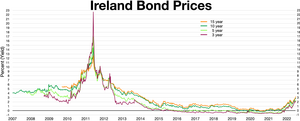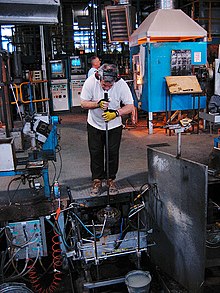Economy of the Republic of Ireland
Ireland is an open economy (3rd on the Index of Economic Freedom),[27] and ranks first for high-value foreign direct investment (FDI) flows.
[38] This growth in GDP, dubbed "leprechaun economics" by American economist Paul Krugman, was shown to be driven by Apple Inc.'s restructuring of its Irish subsidiary in January 2015.
[40][41] Foreign-owned multinationals continue to contribute significantly to Ireland's economy, making up 14 of the top 20 Irish firms (by turnover),[42] employing 23% of the private sector labour-force,[43] and paying 80% of the collected corporation tax.
[54] Global capital markets, who ignored Ireland's private sector credit, and OECD/IMF warnings, when Irish GDP was rising during the Celtic Tiger, took fright in the financial crisis.
[47][55] A particularly dramatic growth in Ireland's 2015 GDP (from 1% in 2013, to 8% in 2014, to 25% in 2015) was shown to be largely driven by Apple restructuring their double Irish subsidiary, ASI, in January 2015.
This led to the Central Bank of Ireland proposing a new replacement metric, modified gross national income (or GNI*), to better represent the "true" Irish economy.
In addition European Union membership was helpful, giving the country lucrative access to markets that it had previously reached only through the United Kingdom, and pumping huge subsidies and investment capital into the Irish economy.
Since 1987, a key part of economic policy has been Social Partnership, which is a neo-corporatist set of voluntary 'pay pacts' between the Government, employers and trade unions.
GDP is significantly greater than GNP (national income) due to the large number of multinational firms based in Ireland.
A recent downturn in residential property market sentiment has highlighted the over-exposure of the Irish economy to construction, which now presents a threat to economic growth.
[99] On the other hand, Ireland recorded the biggest month-on-month rise for industrial production across the eurozone in 2010, with 7.9% growth in September compared to August, followed by Estonia (3.6%) and Denmark (2.7%).
The employment growth of the past that attracted many immigrants from Eastern Europe and propped up demand for property was replaced by rising unemployment.
[103] Irish property developers speculated billions of Euros in overvalued land parcels such as urban brownfield and greenfield sites.
"[105] Irish banks correctly identify a systematic risk of triggering an even more severe financial crisis in Ireland if they were to call in the loans as they fall due.
[126] Contributing factors to growth included a recovering construction sector, quantitative easing, a weak euro, and low oil prices.
[143][144] This included policy statements on expansionary budgets, deficit management plans and proposed cuts to the Universal Social Charge and other taxes.
[146] While Taoiseach Enda Kenny praised the economic growth, and said that Ireland would seek to avoid returning to a "boom and bust" cycle, he noted that other areas of the economy remained fragile.
[155] On 23 June 2016, the United Kingdom voted to leave the European Union, which was widely reported as likely having a negative impact on trade between the UK and Ireland, and the Irish economy in general.
[161] The figures were widely ridiculed[162][163][164][165][166][167] including by Nobel Prize winning economist Paul Krugman who labelled them "leprechaun economics".
[168] The official explanation was that the closure of the "double Irish" scheme at end 2014 (phased out by 2020), led some multinationals to relocate "intangible assets" to Ireland.
The EU forced Ireland to close the "double Irish",[182] but it was replaced (Apple's "capital allowances" and Microsoft's "single malt").
[189][190] The drinks industry employs approximately 92,000 people and contributes 2 billion euro annually to the Irish economy[191] making it one of the biggest sectors.
[196][independent source needed] The multinational engineering sector employs over 18,500 people and contributes approximately 4.2 billion euro annually.
[202] In its Globalization Index 2010 published in January 2011 Ernst and Young with the Economist Intelligence Unit ranked Ireland second after Hong Kong.
This includes Google, Facebook, Twitter, LinkedIn, Amazon, eBay, PayPal and Microsoft; several of which have their EMEA / Europe & Middle East headquarters in Ireland.
The Medical technology (MedTech) sector employs nearly 25,000 people and generates 9.4 billion Euro annually, with over one hundred companies in the country.
[citation needed] The top 10 global technology firms have operations in Ireland including Apple, Google, Facebook and Microsoft.
According to Teagasc, the Irish agri-food sector generated 7% of gross value added (€13.9 billion) during 2016, and accounted for 8.5% of national employment and 9.8% of Ireland's merchandise exports.
By accessing the Irish Stock Exchange, investment companies can market their shares to a wider range of investors (under MiFID although this will change somewhat with the introduction of the AIFM Directive.
Similarly, the insurance industry in Ireland is a leader in both retail markets and corporate customers in the EU, in large part due to the International Financial Services Centre.







